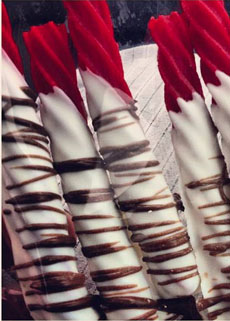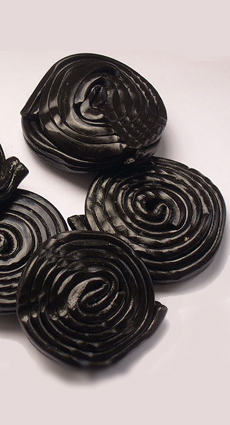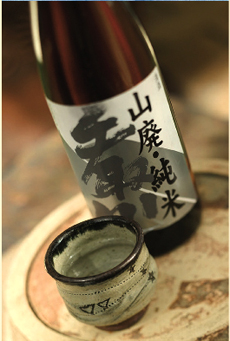|
Here’s a fun idea we found on the Red Vines Facebook page: red licorice enrobed in white chocolate, drizzled with dark chocolate.
You can make them for Halloween. Simply melt white chocolate, dip licorice and dry on wax paper. When white chocolate has dried, drizzle with milk chocolate (use a squeeze bottle).
Licorice is a “healthier candy”: no cholesterol, no salt. Few Americans have grown up without sampling bags of Twizzlers or licorice ropes. But it started out as medicine!
THE HISTORY OF LICORICE
We know licorice as moderately firm, semi-firm gelled candy. But for thousands of years in ancient China, Egypt and Greece, it was a cure for stomach and respiratory ills, as well as a thirst remedy for travelers and soldiers.* The troops of Alexander the Great and the Roman legions used it. Even today, it is used as a homeopathic remedy to soothe irritated membranes and loosen congestion in the upper respiratory tract. It helps as an anti-inflammatory, with allergies and with the liver.
|
|

A “twist” on conventional licorice. Photo courtesy Red Vines. |
|
Use of licorice has been documented for 3,000 years. Ancient Egyptians created a sweet drink from it. Large quantities of licorice root were found in the tomb of King Tut (1356 to 1339 B.C.E.) A popular version of the drink, called mai sus, is still enjoyed in Egypt.
The Caesars advocated licorice as a health remedy. Some 1800 years later, Napoleon Bonaparte chewed licorice for his ongoing digestive problems. Over time, his teeth turned black from the concentration of licorice juice. (You can chew on a piece of licorice root if you want the experience —just don’t make a habit of it.)
Licorice extract is made from the root of the licorice plant, Glycyrrhiza glabra. A member of the pea family that is native to southeastern Europe, licorice grows about four feet high with pretty bluish purple and white flowers that resemble sweet pea blossom. Although they have similar flavor notes, licorice is not related to the spices anise and star anise, the vegetable fennel or the spice tarragon. The relation is that all of these plants and spices contain anethole, an aromatic and sweet-tasting ether compound.
*According to Theophrastus, writing in the third century B.C.E., the Scythians were able to live for 12 days without water because they chewed on licorice root.
|

Black licorice wheels. Photo by Pikaluk | Wikimedia. |
|
To make licorice extract or syrup, the dried root is boiled in water; then most of the water is evaporated. In addition to health remedies and confections, licorice is used in cooking to flavor broths, herbal teas, liqueur and soft drinks. The root can be chewed as a breath freshener. Before the widespread availability of affordable sugar, licorice was used as a sweetener (glycyrrhizin, a component of licorice, is 50 times sweeter than table sugar but also carries with it the strong licorice flavor).
LICORICE FACTS
Around 1500, licorice arrived in Europe with crusaders returning from the Holy Land. Monks continued the homeopathic uses, which spread across Europe during the Renaissance.
Southern Europeans drank licorice tea, believed to be a “blood purifier.”
Dominican friars introduced licorice to England. At some point, some manufacturer began to add honey to the licorice. In the late Middle Ages, licorice pastilles cast in rough molds were widely available.
A monastery in Pointer, England, in Yorkshire, became popular for its licorice discs, stamped with a seal (for decor and branding) and known as “Pointer cakes,” launched in 1614. In 1760, as sugar became affordable, it was added to Pointer cakes, which ratcheted up the popularity of licorice considerably. Pointer Cakes are still manufactured in Pointer, England.
|
|
LICORICE AS A CONFECTION
At some point, licorice, sweetened with honey or sugar, took on a new purpose: candy. While licorice extract continued to be used for medicinal purposes, its sweet chewiness made it a popular treat.
Extruded licorice candy (in tubes and ropes) is believed to have originated in Holland at the beginning of the 17th century.
When the candy industry developed during the Industrial Revolution of the mid-1800s, licorice became one of the standard confections.
Today licorice can be found in the shape of animals (cats, cows, pigs, reindeer, Scotties), bites, coins, drops, jujubes, laces (also called lariats, ropes and vines), pipes, sandwiches (part of an allsorts mix), tubes, twists and wheels and animals.
Krapelien & Holm, a Dutch manufacturer, makes bears, beagles, cars, cats, cones, farm animals, honeybees, lighthouses, thumbs, strawberries and other shapes.
So even if you don’t dip licorice sticks in chocolate, you can still have fun with it.
WHY IS LICORICE PRONOUNCED LICORISH?
The Scots pronounce it “licoriss,” from the Old French “licoresse.” In England and the U.S., it is “licorish.” Here are two theories as to why:
The phoneme may have shifted from /s/ to /sh/, as happened with the words “pressure” and “sugar.”
A 1685 spelling of “licorish” in England leads to speculation is that this pronunciation originated in a regional dialect of English, which changed many final “s” sounds to “sh.”
|
|







